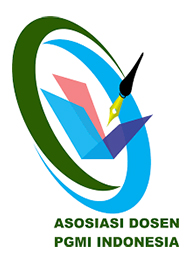Evaluasi Implementasi Kurikulum Program Penjurusan di MI Ma’arif Plus Kuncen Seloboro Salam Magelang
Abstract
Tujuan penelitian ini adalah untuk mengetahui efektivitas penerapan kurikulum program penjurusan yang dilaksanakan di Madrasah Ibtida’iyah Plus Kuncen. Evaluasi adalah bentuk kegiatan yang dilaksanakan untuk menilai dan mengkaji suatu hal. Model evaluasi yang digunakan dalam penelitian ini yaitu model evaluasi CIPP yang dicetuskan oleh Stufflebeam. Penelitian ini menggunakan pendekatan kualitatif dengan bentuk penelitian evaluasi. Model evaluasi yang digunakan dalam penelitian ini adalah model evaluasi CIPP yang mengevaluasi kurikulum berdasarkan beberapa komponen yaitu, 1) Konteks, 2) Input, 3) Proses, 4) Produk. Teknik pengumpulan data dalam penelitian ini menggunakan wawancara, dokumentasi, dan observasi. Teknik keabsahan data menggunakan triangulasi. Teknik analisis data meliputi pengumpulan data, reduksi data, penyajian data, dan penarikan kesimpulan. Hasil analisis menunjukkan, 1) Pada aspek konteks, dasar penyusunan dan tujuan penerapan kurikulum program penjurusan sudah sesuai dengan acuan yang berlaku sehingga aspek konteks termasuk kategori efektif. 2) Aspek Input sudah sesuai karena dukungan dari guru-guru yang telah tersertifikasi. 3) Pada aspek proses, pelaksanaan pembelajaran berpedoman kepada RPP dan penilaian hasil belajar siswa sudah sesuai meskipun di masa pandemi covid-19 pelaksanaannya terbatas, 4) Aspek produk, siswa mendapat laporan hasil belajar dan sertifikat minat bakat.
Kata Kunci: Evaluasi Kurikulum, Model Evaluasi CIPP, Kurikulum Program Penjurusan
Full Text:
PDFReferences
Aliyyah, R. R., & Djuanda, U. (2021). Manajemen Kurikulum (1st ed., Issue March). Samudera Biru.
Anies, B. (2016). Permendikbud No. 20 Tahun 2016 Tentang Standar Kompetensi Lulusan Pendidikan Dasar Dan Menengah. Kemendikbud, 3(2), 13–22.
Arifin, A. S. (2014). Pendidikan Berbasis Hak Anak. LITERASI (Jurnal Ilmu Pendidikan), V(2), 121–136. https://ejournal.almaata.ac.id/index.php/LITERASI/article/view/408/323
Arikunto, S., & Cepi Abdul Jabar, S. (2018). Evaluasi Program Pendidikan Pedoman Teoritis Praktis Bagi Mahasiswa dan Praktisi Pendidikan (2nd ed.). Bumi Aksara. http://staffnew.uny.ac.id/upload/132243758/penelitian/buku cepi - Copy.pdf
Astuti, S., Sedanayasa, G., & Suarjana, I. M. (2015). SD Negeri 1 Baler Bale Agung , Kecamatan Negara e-Journal PGSD Universitas Pendidikan Ganesha. PGSD Universitas Pendidikan Ganesha, 3(1). https://ejournal.undiksha.ac.id/index.php/JJPGSD/article/view/5648/4109
C. Alkin, M. (2011). Evaluation Essntials. In Climate Change 2013 - The Physical Science Basis (2nd ed.). The Guilford Press. https://www.cambridge.org/core/product/identifier/CBO9781107415324A009/type/book_part
Donald L Kirkpatrick, J. D. K. (2006). Evaluating Training Program (3th ed.). Berrett Koehler Publisher. file:///D:/Donald L Kirkpatrick Ph.D. - Evaluating Training Programs_ The Four Levels ( (2006, Berrett-Koehler Publishers) - libgen.lc.pdf
Imam Dr. Sutomo. (2015). Pengembangan Instrumen Evaluasi Cipp ( Context Input Process and Product ) Pada Program Ma ’ Had Aly Di Perguruan Tinggi Keagamaan Islam Negeri (pp. 1–61).
KEMENAG. (2013). Peraturan Menteri Agama Nomor 90 Tahun 2013 (pp. 3–4). https://dki.kemenag.go.id/media/laws/3-191031104059-5dba57cb07927.pdf
Luma, M., Tola, A., & Hadirman, H. (2020). Evaluasi Implementasi K-13 Berdasarkan Model CIPP di SDN 2 Tabongo Kabupaten Gorontalo. Jurnal Ilmiah Iqra’, 14(2), 186. https://doi.org/10.30984/jii.v14i2.1307
Madrasah, D. K. (2019). Keputusan Menteri Agama Tentang Pedoman Impelentasi Kurikulum Pada Madrasah. 20. https://sumsel.kemenag.go.id/files/sumsel/file/file/1pengumuman17/k_kma_nomor_184_tahun_2019_tentang_pedoman_implementasi_kurikulum_pada_madrasah-dikompresi_pdf-20190911134221.pdf
Manuaba, I. B. S., Pendidikan, J., Sekolah, G., & Ganesha, U. P. (2015). Dari Cipp Pada Sekolah Dasar Negeri Di Wilayah Perkotaan Kabupaten Badung. 3. https://ejournal.undiksha.ac.id/index.php/JJPGSD/article/view/5035/3799
Munthe, A. P. (2015). Pentingya Evaluasi Program di Institusi Pendidikan: Sebuah Pengantar, Pengertian, Tujuan dan Manfaat. Scholaria : Jurnal Pendidikan Dan Kebudayaan, 5(2), 1. https://doi.org/10.24246/j.scholaria.2015.v5.i2.p1-14
Muttaqin, M. E. (2020). Evaluasi Kurikulum Pendidikan Islam. Prosiding Nasional, 3, 171–180. http://prosiding.iainkediri.ac.id/index.php/pascasarjana/article/view/49/39
Nugraheni, E. P. (2019). Implementasi Kurikulum 2013 Pada Pembelajaran PAI Siswa Tunagrahita ( Studi Kasus Siswa Tunagrahita Sedang Kelas VII di SLB N 2 Yogyakarta ) 1. X(2), 140–150. https://ejournal.almaata.ac.id/index.php/LITERASI/article/view/1128/1191
Nurjanah, A. (2016). Model Kurikulum Terpadu dalam Pembelajaran Pendidikan Agama Islam (Vol. 18, Issue 2). http://dx.doi.org/10.1016/j.jplph.2009.07.006%0Ahttp://dx.doi.org/10.1016/j.neps.2015.06.001%0Ahttps://www.abebooks.com/Trease-Evans-Pharmacognosy-13th-Edition-William/14174467122/bd
Pemerintah, P. (2021). Peraturan Pemerintah Republik Indonesia Nomor 57 Tentang Standar Nasional Pendidikan (pp. 1–49). https://peraturan.bpk.go.id/Home/Details/165024/pp-no-57-tahun-2021
Permendikbud. (2007). Permendikbud Nomor 24 Tahun 2007 Tentang Standar Sarana dan Prasarana.
Permendikbud. (2018). Permendikbud RI Nomor 37 tahun 2018 tentang Perubahan atas Peraturan Menteri Pendidikan dan Kebudayaan Nomor 24 tahun 2016 tentang Kompetensi Inti dan Kompetensi Dasar Pelajaran pada Kurikulum 2013 pada Pendidikan Dasar dan Pendidikan Menengah. JDIH Kemendikbud, 2025, 1–527. https://jdih.kemdikbud.go.id/arsip/Permendikbud Nomor 37 Tahun 2018.pdf
Retnawati, H. (2011). Evaluasi program pendidikan nonformal (p. 2).
Rizal, S. U., Sulistyowati, S., & Syabrina, M. (2018). Pengembangan kurikulum Madrasah Ibtidaiyah. Harapan Cerdas. http://digilib.iain-palangkaraya.ac.id/1339/%0Ahttp://digilib.iain-palangkaraya.ac.id/1339/1/Ebook Pengembangan Kurikulum Madrasah Ibtidaiyah %282%29.pdf
Rusydi Ananda, T. R. (2017). Pengantar evaluasi program pendidikan (C. Wijaya (ed.)). Perdana Publishing. http://repository.uinsu.ac.id/2842/1/Evaluasi Program Pendidikan.pdf
Sabda, S. (2016). Pengembangan Kurikulum. In Cetakan Ke-1. Bandung: PT Refika Aditama. Aswaja Pressiindo. https://adoc.pub/queue/pengembangan-kurikulumd45904aed46720cdb0642cf6fa92b05641738.html
Sanusi, A. (2020). Evaluasi Program Salat Duha Berjamaah Dengan Pendekatan CIPP (Studi Kasus Di Madrasah Ibtidaiyah Al Jauhar). Lit.
Shier, M. L. (2012). Book Review: Handbook of Practical Program Evaluation. Nonprofit and Voluntary Sector Quarterly, 41(6), 1269–1272. https://doi.org/10.1177/0899764011420366
Stufflebeam, D. L. (2003). The CIPP Model for Evaluation. International Handbook of Educational Evaluation, 31–62. https://doi.org/10.1007/978-94-010-0309-4_4
Stufflebeam, D. L. (2015). CIPP evaluation model checklist: A tool for applying the CIPP model to assess projects and programs: Evaluation Checklists Project. https://www.wmich.edu/sites/default/files/attachments/u350/2014/cippchecklist_mar07.pdf
Sudarman. (2019). Buku Ajar Pengembangan Kurikulum. In L. Subagyo (Ed.), Akrab Juara (1st ed., Vol. 5, Issue 1). Mulawarman University Press. http://www.akrabjuara.com/index.php/akrabjuara/article/view/919
Sugiyono. (2015). Metode Penelitian Kuantitatif, Kualitatif dan R&D. Alfabeta.
Sukati. (2016). Konsep Dan Struktur Pengembangan Kurikulum SD/MI. LITERASI (Jurnal Ilmu Pendidikan), 3(1), 61. https://doi.org/10.21927/literasi.2012.3(1).61-76
DOI: http://dx.doi.org/10.21927/ijeeti.2022.1(2).24-32
Refbacks
- There are currently no refbacks.
Indonesian Journal of Elementary Education and Teaching Innovation ( IJEETI ) indexed by:

IJEETI by Authors is licensed under CC BY-SA 4.0






